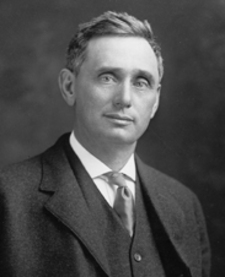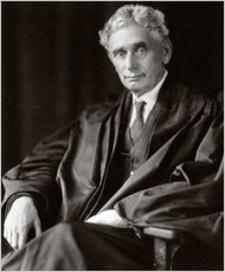
On January 28, 1916 -- 100 years ago -- President Woodrow Wilson nominated Louis Brandeis to be the first Jew on the U.S. Supreme Court. It was the most hotly debated nomination in American history up to that time. The controversy involved Brandeis' progressive political views as well as his religion.
Today, we take it for granted that Supreme Court nominations will trigger controversy. Conservative activists and Republican Senators oppose almost anyone whom a Democratic president nominates and vice versa. Everything nominees have written or said in public is scrutinized and they are grilled at Senate confirmation hearings. Up until Brandeis' nomination, however, presidents faced little resistance to appointing their picks to the nation's highest court.
Brandeis' nomination was different. On February 9, 1916, a Senate subcommittee considering a Supreme Court nominee held a public hearing for the first time, hoping to embarrass Brandeis. The four month lag between Wilson's announcement and the Senate's approval of Brandeis' appointment was the longest in history at the time.
Brandeis' opponents included anti-semites and those who disliked Brandeis' progressive views on labor and civil liberties. Anti-semitism was widespread in America during that period. Jews were banned from many jobs and clubs. Many colleges had quotas limiting the number of Jewish students. Movies, plays, and vaudeville were rife with negative stereotypes about Jews. The Ku Klux Klan was on the rise, whipping up hysteria against Jews, Catholics, and African Americans. The year before, the Supreme Court had rejected, by a 7-2 vote, an appeal by Leo Frank, a Jewish businessman from Atlanta, to overturn his murder conviction despite overwhelming evidence that his trial had been unfair, biased by the climate of anti-semitism.
Some of Brandeis' opponents were overt in their bigotry while others resorted to code words. Former President William Howard Taft, along with six former presidents of the American Bar Association, signed a letter urging the Senate to reject Brandeis as unfit. Taft called Brandeis' nomination "an evil and a disgrace." More than forty witnesses -- many of them members of Boston's Brahmin upper class who had been on the losing side of cases that Brandeis had prosecuted -- testified against him at the Senate hearing, claiming, without proof, that he had engaged in unethical and unprofessional conduct. Abbott Lawrence Lowell, the president of Harvard University (Brandeis's alma mater), along with other upper-class Bostonians, signed a letter opposing Brandeis. They claimed he was "unscrupulous," and lacked "judicial temperament and capacity," although, when asked, Lowell admitted he had no evidence for these statements. Senator Henry Cabot Lodge, a Massachusetts Republican, claimed that Wilson had nominated Brandeis simply to get Jewish votes for his upcoming re-election campaign.
The anti-semites might have been irrational bigots, but big business' opposition to Brandeis was understandable and entirely justified. As a "people's lawyer" in Boston, Brandeis fought railroad monopolies, defended workplace and labor laws, and helped create policies to limit corporate abuses of consumers and workers--an approach that is now called "public interest" law. He believed that fighting injustice involved more than courtroom combat. He wrote books and articles in order to influence public opinion, advised many politicians and reform groups who shared his commitment to taming corporate power.
In an editorial, the New York Times warned that Brandeis espoused "radicalism." The Wall Street Journal went even further: "In all the anti-corporate agitation of the past, one name stands out. Where others were radical, he was rapid."
Finally, on June 1, the Senate confirmed Brandeis by a vote of 47-22. It was almost a straight party-line vote. He was supported by all the Democrats but one and by three progressive Republicans, including Robert M. La Follette.
Born in Louisville, Kentucky, and raised in a secular Jewish family, Brandeis entered Harvard Law School at age nineteen and graduated in 1877 with the highest grades in the school's history. With his classmate and law practice partner Samuel Warren, he wrote one of the most famous law articles in history, "The Right to Privacy," published in the December 1890 Harvard Law Review. In it, they argued that people have "the right to be let alone."
By the early 1890s, Brandeis's law practice was a financial success, which gave him the freedom to pick and choose clients, including many public causes, without asking for money. This made Brandeis one of the first pro bono lawyers. Although he was a skilled and successful litigator, he preferred the roles of broker, mediator, and adviser.
Fearing the influence of big business over everyday life, he led a campaign to prevent a private transit corporation from controlling Boston's municipal subway system, and he persuaded the state legislature to adopt a savings-bank life insurance system. Brandeis also waged a successful fight to stop financier J. P. Morgan's efforts to merge his giant New Haven Railroad with its chief competitor, the Boston and Maine Railroad, which would have given Morgan a virtual monopoly on rail transportation in New England.
In 1894, prodded by his friend Alice Lincoln, a Boston philanthropist and crusader for the poor, Brandeis spent nine months and held 57 public hearings investigating the awful conditions in Boston's public poorhouses, where the temporarily jobless were crowded together with the mentally ill and hardened criminals. At one hearing he said, "Men are not bad and men are not degraded largely by circumstances because they desire to be so. It is the duty of every man to help them up and let them feel that there is some hope for them in life." The publicity from the hearings pressured Boston's officials to reform the city's poor laws to provide better food and housing.
Brandeis's most influential legal case was the 1908 US Supreme Court ruling in Muller v. Oregon. In 1907, Brandeis's sister-in-law Josephine Goldmark, along with Florence Kelley, head of the National Consumers League, persuaded Brandeis to defend Oregon's maximum-hour law for women. At issue was whether a state could limit the hours that women could work. Employers argued that Oregon's law was an infringement on the "freedom of contract" between employers and their employees. Brandeis presented his case by documenting the "clear connection between the health and morals of female workers" and the hours that they were required to work. His legal argument was relatively short, but he included more than 100 pages of documentation -- pulled together by Kelley and Goldmark -- including reports from social workers, doctors, factory inspectors, and other experts.
The Supreme Court upheld Oregon's law. Brandeis's groundbreaking approach to legal briefs would soon came to be known as the "Brandeis Brief" -- one based on data as well as legal theory -- and it became widespread over the next century.
Brandeis viewed the power of big business as a serious threat to a good society. The greatest problem the American people faced, he wrote in The Curse of Bigness, "is the problem of reconciling our industrial system with the political democracy in which we live." The antidote to the excess of corporate power was what he called "industrial democracy," which meant, in part, giving workers a voice through their labor unions. In 1907, Brandeis had served as the lawyer for Boston's cloak manufacturers during an acrimonious labor dispute, getting a court injunction against picketing, which crushed the strike. Three years later, however, Brandeis plunged into a crusade to bring industrial democracy to New York's clothing industry.
In 1910, over 60,000 cloak makers, mostly men, went on strike in what was called the "Great Uprising." Operating as a neutral mediator, Brandeis sought to bring the manufacturers (represented by their Cloak, Suit, and Skirt Protective Association) and the workers (represented by the International Ladies' Garment Workers Union) together to hammer out an industry-wide agreement. With Brandeis's nudging, the two sides signed the Protocol of Peace, an agreement that set minimum industry standards on wages, hours, piece rates, and sanitation (workplace safety and health). In addition, Brandeis hoped that the protocol would make strikes less likely.
Many observers, including Brandeis, viewed the protocol as a major milestone, recognizing that both owners and workers had a shared stake in efficiency and prosperity. Soon the agreement covered the entire industry and laid the foundation for future workplace reforms during the New Deal. But the protocol's weakness was that it was a voluntary agreement, not a government regulation, and not all manufacturers signed on. One such holdout was the Triangle Shirtwaist Company, where, on March 25, 1911, 146 immigrant workers, mostly young girls, perished in a tragic fire in a factory where conditions violated many of the protocol standards.
Brandeis's writings and activism changed not just the law but also American attitudes about the need to restrain corporate power. His 1914 book, Other People's Money--And How the Bankers Use It, carefully showed how the interlocking network of directors of banks (whom he called "the dominant element in our financial oligarchy") and of railroads, insurance companies, and other corporations gave J. P. Morgan and a handful of other corporate titans undue influence over the economy and the political system. They were not even putting their own money at risk, Brandeis explained, which allowed them to make more reckless decisions than they otherwise would have. These oligarchs, Brandeis wrote, thus achieved "the supposedly impossible feat of having their cake and eating it too."
Brandeis shared some of the progressives' preference for regulation, but unlike most progressives, he was generally skeptical of "bigness" in both business and government. He thought the most pro-consumer approach to restraining corporate power was to break huge corporations and overlapping trusts into smaller firms, which he believed would catalyze more competition and weaken their grip on political power.
Using his expertise on corporate practices, he served as one of President Wilson's key economic advisers, persuading the president to create the Federal Reserve System and the Federal Trade Commission and to push for the Clayton Antitrust Act and the Sixteenth Amendment, ratified in 1913, which allowed Congress to levy an income tax. Brandeis believed that public disclosure of big corporations' huge fees, commissions, salaries, and profits would mobilize voter anger. "Publicity is justly commended as a remedy for social and industrial diseases," Brandeis wrote. "Sunlight is said to be the best of disinfectants."
After winning the White House in 1912, Wilson hoped to appoint Brandeis as his secretary of commerce, but when the news leaked to the press and sparked intense opposition, he picked someone else.
Four years later, however, Wilson felt the time was right to put Brandeis on the Supreme Court. Despite the unprecedented campaign waged against his nomination, Brandeis prevailed and served on the court for 23 years, until 1939.
On the Supreme Court, Brandeis was a key architect of rulings to protect free speech and to strengthen the right to privacy. During several decades of dramatic changes in public policy, Brandeis was typically on the side of progressive reform, but with his own twist. Brandeis viewed states as "laboratories" for innovative public policies. Not surprisingly, at a time when states were enacting a variety of progressive laws protecting workers and consumers, Brandeis advocated judicial constraint, encouraging his Court colleagues to give state legislators the benefit of the doubt. "The most important thing we do is not doing," he said about the Court.
Despite his personal skepticism about bigger government, he voted to uphold President Franklin D. Roosevelt's New Deal programs, which often faced challenges in the courts on the grounds that they exceeded government's right to regulate business.
On some matters, however, Brandeis opposed FDR, including his effort to increase the number of seats on the Supreme Court as a means of reducing challenges to his legislation. In 1935, Brandeis voted with the Court majority in Schecter Brothers v. the United States to nullify the 1933 National Industrial Recovery Act, which allowed the federal government to establish codes of fair practice to limit cutthroat competition within each industry.
Brandeis' other major crusade was American Zionism. He was a secular Jew who celebrated Christmas. But he supported the idea of Jews' having a homeland, based on social justice and Jewish prophetic principles. At the time, many German Jews -- who were more affluent and more assimilated than Jewish immigrants from Eastern European -- were eager to be seen as patriotic Americans and unsympathetic to European Zionism. In 1914 Brandeis was elected chair of the Provisional Committee for General Zionist Affairs and spent much of his time and energy rallying fellow Jews as well as non-Jews in support of a Jewish state. Brandeis died in 1941, seven years before Israel's birth. In 1948, the same year that Israel was founded, at a time when many colleges still had Jewish quotas, Jewish educators and philanthropists started a nonsectarian Jewish-sponsored university in Waltham, Massachusetts and named it after Brandeis. The school's athletic teams are called the Judges, while the student newspaper is called The Justice.
In 1932, Brandeis was joined on the Supreme Court by another Jew, Benjamin Cardozo, who was appointed by President Herbert Hoover and served until 1938. But the next three Jews on the high court were only nominated after a Jewish justice had died or retired. After Cardozo died in 1938, FDR appointed Felix Frankfurter, who served until 1962. When Frankfurter retired in 1962, President John F. Kennedy named another Jew, Arthur Goldberg, to succeed him. In 1965, President Lyndon Johnson persuaded a reluctant Goldberg to leave the court to become America's United Nations Ambassador. Then, LBJ nominated Abe Fortas, another Jew, to succeed Goldberg. That trend led some observers to suggest that presidents thought there should be one "Jewish seat" on the Supreme Court.
But President Richard Nixon, whose private anti-Semitic comments were exposed when his secret White House tape-recordings were made public, ended the so-called "Jewish seat" tradition. After Fortas was forced to resign in the midst of a corruption scandal in 1969, Nixon nominated Clement Haynsworth (whom the Senate turned down) and then G. Harrold Carswell (whom the Senate also rejected), and finally Harry Blackmun, a Methodist whom the Senate approved. No Jew served on the Supreme Court for another 24 years until President Bill Clinton named Ruth Bader Ginsburg to the court in 1993. The following year, Clinton appointed another Jew, Stephen Breyer, to the high court. When President Barack Obama named Elena Kagan in 2010, it marked the first time in history that three Jews served simultaneously on the Supreme Court.
In many ways, Brandeis anticipated the current outrage about widening inequality, epitomized by Occupy Wall Street's now-popular slogan about the 1 percent and the 99 percent and by the growing public disgust at the reckless and irresponsible practices of the financial industry, Walmart, and other giant corporations.
"We can have democracy in this country, or we can have great wealth concentrated in the hands of a few," Brandeis wrote, "but we can't have both."
Peter Dreier teaches politics and chair the Urban & Environmental Policy Department at Occidental College. His most recent book is The 100 Greatest Americans of the 20th Century: A Social Justice Hall of Fame (Nation Books).


